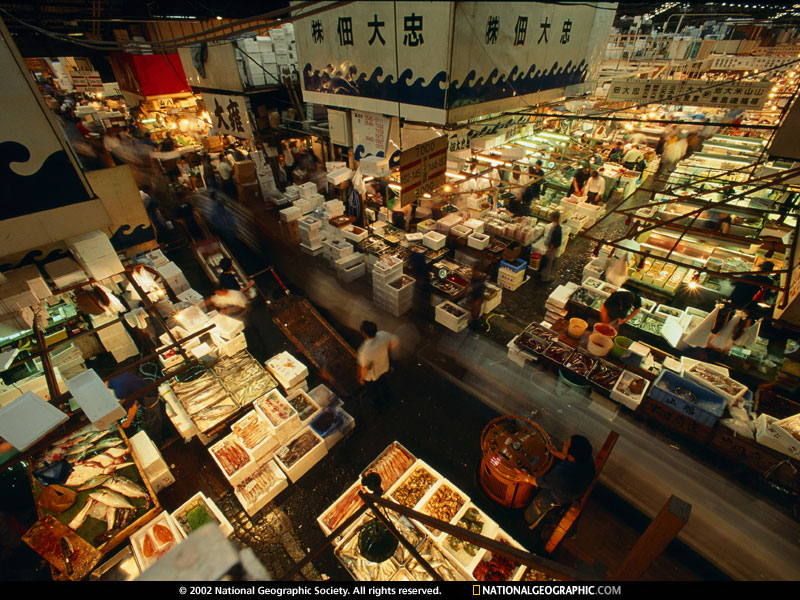
Asian fish market (Tsukiji Japan) – the world’s largest single fish market.
The problem for seafood is that it is relatrively expensive to produce via both wild catch and aquaculture. As such its price is generally equal to or higher than other alternatives. Price is often the critical factor in the supply and demand equation for comparable products. The simple relationship between price and volume sold is very difficult to diverge from. Basically, the lower the price, you sell more – the higher the price, you sell less. To diverge significantly from this relationship requires excellent marketing and promotion of:
The table below shows total fish supply consumed by region/continent and economic grouping. Of significance – Asia consumes 68 % (85.4M T) of the world’s seafood. Half of this (42.6M T) is consumed by China alone. China consumes more seafood than Europe, North America, South America and Africa combined and one third of all seafood consumed globally. The significance of these statistics for NZ seafood producers must not be ignored. Seafood is mainly produced and consumed in Asia. Furthermore – the Asian markets are consuming more premium/higher priced seafoods. The NZ seafood market is small and insignificant in the global context but not in the context of a small to medium producer of seafood.

World food fish supply (consumption), TOTAL and Per Capita, 2009 (FAO 2012)

Auckland fish market – a relatively small affair in comparison to Asian fish markets
In the New Zealand seafood context there is likely to be high demand with good prices for low to medium production. Using the examples of hapuka and kingfish, it is estimated demand and price will be good until production reaches approximately 500-1,000T per annum. At this production level, producers will either need to become more efficient and lower their prices – or look at good export markets. Using the hapuka/kingfish example, only 1 or 2 producers could easily supply 500 – 1,000T.
The relatively small domestic market in NZ and our geographical isolation (distance) from the export markets of the EU, USA, Asia and Australia are major hurdles for NZ producers. That said NZ has a history of successful exports in primary products including seafood. NZ King Salmon is exported fresh and frozen to Asia, USA and Australia.
In most product forms, consumer preferences in premium seafood are for fresh chilled product. This is a strong global trend. Aquaculture needs to be in the premium seafood sector to achieve the price required to be profitable. Any exports of fresh chilled seafood from NZ is therefore required to be air freighted adding significant cost which disadvantages NZ product in export markets. Barramundi, kingfish, cobia and tilapia producers in Australasia can get their product to their local market cheaper than NZ producers will be able to for Hapuka and kingfish. Economies in scale allow the salmon producers to leverage good freight rates within and out of NZ.
NZ faces strong competition from global producers both in the domestic and export markets. Salmon from Norway, Denmark and Australia is readily available in NZ at very competitive prices. The NZ suppliers are able to compete very well however on quality as the products available from these overseas sources is often not premium. Tilapia and pangasius dominate the low to medium price seafood market globally.
The export market is not necessarily a viable route for establishing and for growth of a NZ aquaculture business. Good marketing and promotion are the keys to export markets but they are expensive and the results sometimes random. Some markets are fickle so it is important as with most things that in order to be successful an experienced and successful person or persons is employed. Selling via the most direct route to the end user (e.g. direct to restaurants, hotel chains) is an important strategy for successful seafood exports from NZ.
Information on NZ seafood exports can be found at the following pages.